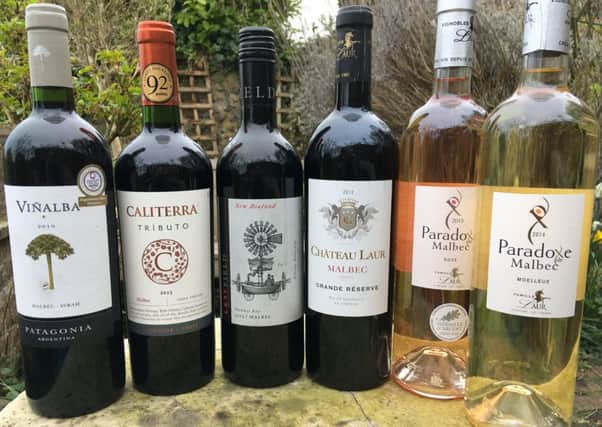RICHARD ESLING: Malbec needs just the right conditions


However, it applies not just to people, but also to other items that these emigrants took with them – such as vines. Many of the French pioneers who settled in Chile and Argentina, were already growing vines and making wine in their home country, so naturally they took some vines and cuttings with them.
One such vine variety was Malbec. With World Malbec Day falling this week (April 17 to be precise), what better time to go out and buy a bottle or two? This grape variety was once one of the main varieties grown for Bordeaux reds and is still grown there, albeit in much smaller quantities. It is one of the six red grape varieties allowed in the blends for these wines. However, the numbers of Malbec vines grown in the Bordeaux region was drastically reduced after the devastating winter of 1956.
Advertisement
Hide AdAdvertisement
Hide AdTemperatures were so low for so long that many of the vines were killed and great areas of the vineyards had to be replanted. Since Malbec is a more difficult grape variety to cultivate, being prone to disease and needing just the right climatic conditions, very little of the Malbec was replanted, being replaced by the easier and more adaptable Cabernet Sauvignon and Merlot. Further south-west, around the town of Cahors, conditions are drier and more suitable to Malbec and it is the king variety in this region. One top producer, Chateau Laur, even produces white, rosé, sweet and sparkling wines from the variety.
Returning to our French pioneering wine-makers, they took many different grape varieties with them and planting them in different countries with different climatic conditions, soils and terroirs, was largely experimental. Some worked better than others and one of the great successes, particularly in South America, was and is Malbec. The original clone of the variety has developed over nearly 200 years and has adapted so well in Argentina that some of the best Malbec wines in the world are made there.
Argentina today is the prime maker of Malbec wines, with some 80 percent of the world production based here. The wines are mellow, fruity and deeply coloured, with no harsh tannins. It is thought that the variety came to Argentina via Chile, where it also makes some excellent wines on the other side of the Andes mountain range. The sunny, dry climate, with gentle breezes to keep the vines disease free, is perfect, particularly at some higher altitude sites, which moderate the temperatures.
A great example of Malbec from Chile, rather than Argentina, is the Caliterra Tributo Malbec 2015 from Colchagua Valley. The deep clay-loam soils are strewn with sharp schist stones, which add to the mineral profile of the wines. Partly fermented in used French oak barrels, the wine is then matured for 12 months in French oak, nine percent of which is new to attenuate the tannin levels.
Advertisement
Hide AdAdvertisement
Hide AdThe deeply coloured wine has a fresh and vivid style, with intense red berries and soft spice and a touch of sweet almonds and herbs on the nose. Soft tannins balanced by crisp acidity gives an overall elegance and excellent value at around £13.30 from online merchants such as North and South Wines in Wandsworth, London.
Malbec has also found new homes in other New World countries. The 2014 Left Field Malbec from Hawkes Bay in New Zealand is deep flavoured, mellow and delicious. £17.45 from Noble Grape Wines or www.nzhouseofwine.co.uk. Its somewhat ‘wacky’ description runs thus: “Down a dark alleyway the brooding and intense characters of blackberry and liquorice meet the heroically proportioned mass of dark chocolate, draped in smooth, fine velvet.”
Perfect wines for World Malbec Day.
Richard Esling BSc DipWSET is an experienced wine consultant, agent, writer and educator. An erstwhile wine importer, he runs a wine agency and consultancy company called WineWyse, is founder and principal of the Sussex Wine Academy, chairman of Arundel Wine Society and is an International Wine Judge. Twitter @richardwje. Visit www.winewyse.com.
Don’t miss out on all the latest breaking news where you live.
Advertisement
Hide AdAdvertisement
Hide AdHere are four ways you can be sure you’ll be among the first to know what’s going on.
1 Make our website your homepage
2 Like our Facebook page
3 Follow us on Twitter
4 Register with us by clicking on ‘sign in’ (top right corner). You can then receive our daily newsletter AND add your point of view to stories that you read here.
And do share with your family and friends – so they don’t miss out!
Be part of it.